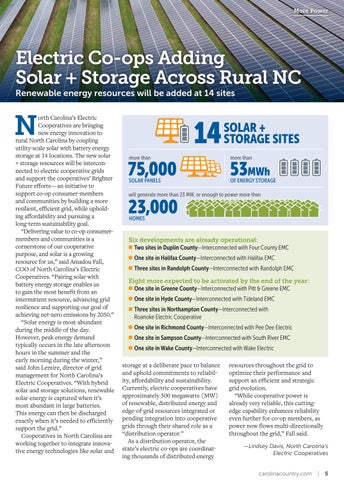More Power
Electric Co-ops Adding Solar + Storage Across Rural NC Renewable energy resources will be added at 14 sites
N
orth Carolina’s Electric Cooperatives are bringing new energy innovation to rural North Carolina by coupling utility-scale solar with battery energy storage at 14 locations. The new solar + storage resources will be interconnected to electric cooperative grids and support the cooperatives’ Brighter Future efforts — an initiative to support co-op consumer-members and communities by building a more resilient, efficient grid, while upholding affordability and pursuing a long-term sustainability goal. “Delivering value to co-op consumermembers and communities is a cornerstone of our cooperative purpose, and solar is a growing resource for us,” said Amadou Fall, COO of North Carolina’s Electric Cooperatives. “Pairing solar with battery energy storage enables us to gain the most benefit from an intermittent resource, advancing grid resilience and supporting our goal of achieving net-zero emissions by 2050.” “Solar energy is most abundant during the middle of the day. However, peak energy demand typically occurs in the late afternoon hours in the summer and the early morning during the winter,” said John Lemire, director of grid management for North Carolina’s Electric Cooperatives. “With hybrid solar and storage solutions, renewable solar energy is captured when it’s most abundant in large batteries. This energy can then be discharged exactly when it’s needed to efficiently support the grid.” Cooperatives in North Carolina are working together to integrate innovative energy technologies like solar and
14 more than
75,000 SOLAR PANELS
SOLAR + STORAGE SITES more than
53MWh
OF ENERGY STORAGE
will generate more than 23 MW, or enough to power more than
23,000 HOMES
Six developments are already operational: ■ Two sites in Duplin County—Interconnected with Four County EMC ■
One site in Halifax County—Interconnected with Halifax EMC
■
Three sites in Randolph County—Interconnected with Randolph EMC
Eight more expected to be activated by the end of the year: ■ One site in Greene County—Interconnected with Pitt & Greene EMC ■
One site in Hyde County—Interconnected with Tideland EMC
■
Three sites in Northampton County—Interconnected with Roanoke Electric Cooperative
■
One site in Richmond County—Interconnected with Pee Dee Electric
■
One site in Sampson County—Interconnected with South River EMC
■
One site in Wake County—Interconnected with Wake Electric
storage at a deliberate pace to balance and uphold commitments to reliability, affordability and sustainability. Currently, electric cooperatives have approximately 500 megawatts (MW) of renewable, distributed energy and edge-of-grid resources integrated or pending integration into cooperative grids through their shared role as a “distribution operator.” As a distribution operator, the state’s electric co-ops are coordinating thousands of distributed energy
resources throughout the grid to optimize their performance and support an efficient and strategic grid evolution. “While cooperative power is already very reliable, this cuttingedge capability enhances reliability even further for co-op members, as power now flows multi-directionally throughout the grid,” Fall said. —Lindsey Davis, North Carolina’s Electric Cooperatives carolinacountry.com | 5
CC07_WK.indd 5
6/10/22 3:24 PM








